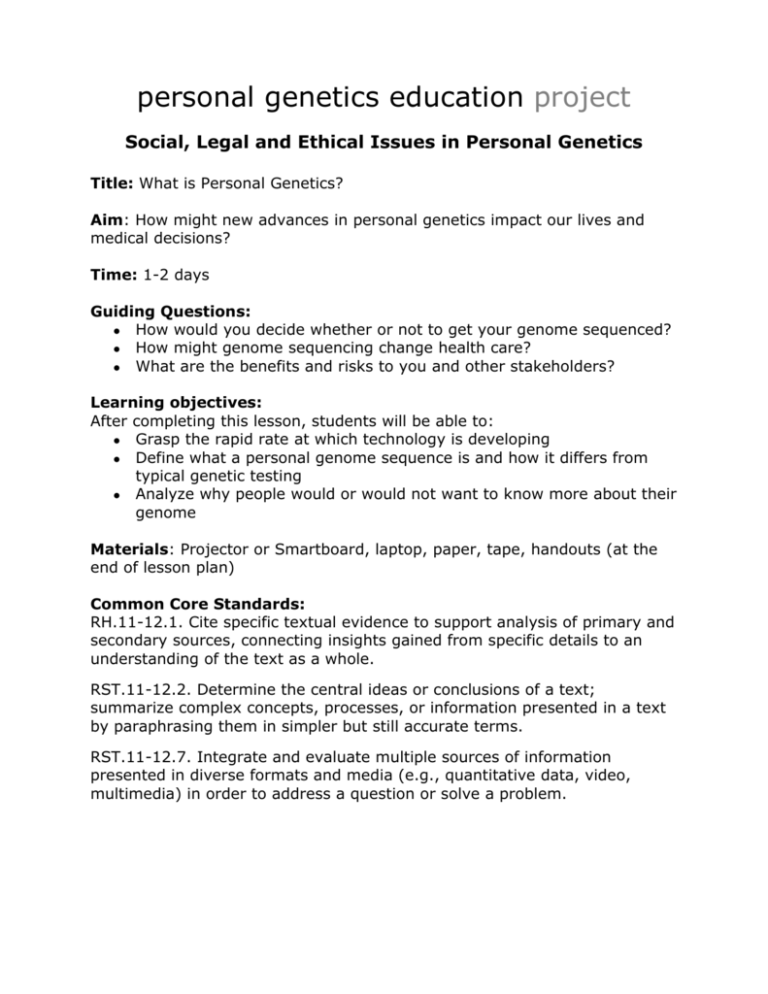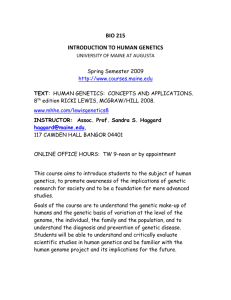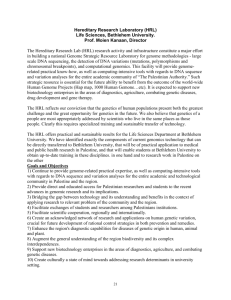Word Document - Personal Genetics Education Project
advertisement

personal genetics education project Social, Legal and Ethical Issues in Personal Genetics Title: What is Personal Genetics? Aim: How might new advances in personal genetics impact our lives and medical decisions? Time: 1-2 days Guiding Questions: ● How would you decide whether or not to get your genome sequenced? ● How might genome sequencing change health care? ● What are the benefits and risks to you and other stakeholders? Learning objectives: After completing this lesson, students will be able to: ● Grasp the rapid rate at which technology is developing ● Define what a personal genome sequence is and how it differs from typical genetic testing ● Analyze why people would or would not want to know more about their genome Materials: Projector or Smartboard, laptop, paper, tape, handouts (at the end of lesson plan) Common Core Standards: RH.11-12.1. Cite specific textual evidence to support analysis of primary and secondary sources, connecting insights gained from specific details to an understanding of the text as a whole. RST.11-12.2. Determine the central ideas or conclusions of a text; summarize complex concepts, processes, or information presented in a text by paraphrasing them in simpler but still accurate terms. RST.11-12.7. Integrate and evaluate multiple sources of information presented in diverse formats and media (e.g., quantitative data, video, multimedia) in order to address a question or solve a problem. Before the lesson: If you have not done a full unit on genetics (particularly if the lesson is used in a health, ethics, or non-science class), explain to students that many diseases are passed down from parent to child through their genes. A resource that students can explore on their own to learn more about heredity, genes and traits can be found at the award-winning site at the University of Utah: http://learn.genetics.utah.edu/. Click on the “Heredity and Traits” link in the box on the left under Basics. For a reading for students to lay out some of the big ideas in genetics at the moment, we recommend Mary Carmichael’s excellent series she wrote for Newsweek in 2010. If you are going to read only once piece from the sixpart series, start at the beginning! “DNA Dilemma: Should I take a genetic test?” Mary Carmichael, Newsweek. http://www.thedailybeast.com/newsweek/2010/08/02/dna-dilemma-onewriter-s-week-long-quest-to-determine-if-she-should-take-an-at-homegenetic-test.html For the teacher: High school and college age students are likely to become independent health care consumers at about the time that personal genome sequencing becomes an affordable and accessible option for many people. This lesson introduces them to the recent advances in genetics, genetic testing, and personal genome sequencing, and presents some of the decisions and ethical challenges an individual may face regarding the use of this technology. It also introduces some of the likely benefits of personal genomes, such as gaining the ability to act on one’s genetic risks, tailoring medicines and interventions, and becoming more active and engaged healthcare consumers. Via class discussion and the readings, students will be able to generate ideas about the possible risks and benefits. Do now: Students should answer questions individually. (7 min) If you could find out the probability that you would develop specific diseases such as Alzheimer’s or diabetes in the future, would you want to know? Why or why not? Would it make a difference if there were treatments available or not? Think of both a positive and negative outcome to knowing this information. Discuss student answers after they have finished. Activity: 1. Interactive Slideshow (15 - 20 min) We have created a Powerpoint slideshow, along with notes for the teacher, (located under the lesson plan link here: http://www.pged.org/lessonplans/) that explores what types of information people can learn from genome sequencing (testing all of your genes at once), the hopes and limits of sequencing, and how this information may impact us. One important point to make to your students is that genetics can make predictions about your health risks and other traits, but does not tell the future. The intricate relationship between genetics and environment is key to behavior and health. Depending on your preference, you may want students to take notes to help evaluate their understanding, particularly if you will be using additional lesson plans and students will later participate in a debate and/or writing activity. One excellent method for note-taking is Two-Column Note Taking. A handout of a graphic organizer for this is at the end of the lesson plan, but students can take notes in their notebook or journal as well. 2. Four Corners Activity (15 - 25 min, depending on depth of discussion) For this activity, students will hear several statements, and move to labeled corners of the room based on whether they agree or disagree with each statement, and then discuss their opinions. Step one: Preparation Label the four corners of the room before students enter with signs reading: strongly agree, agree, disagree, and strongly disagree. You could also do a straight line across the room with students placing themselves on the continuum between strongly agree and strongly disagree; the best set up likely depends on your classroom. Tell students: The new advances in genetics and genome sequencing offer great hope for medicine and health; at the same time, there are risks and questions that loom large for consumers. The statements below offer students a chance to express their opinion and discuss some of the issues with their classmates. Step two: Introduce Statements: Read each statement (or as many as you have time for) and have students move to the corner of the room depending on whether they strongly agree, agree, disagree, or strongly disagree. After they move to the corner, have them discuss in their groups why they agree/disagree. Once students are in their places, ask for volunteers to explain their position; they should cite, when applicable, information from the article that supports their position. Encourage students to switch corners if someone presents an idea that causes them to change their opinion. After a representative from each corner has defended his or her position, you can allow students to question each other’s evidence and ideas. Before beginning the discussion, remind students about norms for having a respectful, open discussion of ideas. Note: You can do this activity in different ways, depending on preference/time/class size and configuration, etc. You can read/display the statements and have kids choose on the spot whether they agree or disagree, and discuss with their groups and then the whole class. If you have longer class periods and/or will use this as a pre-writing activity for either an essay or debate, you can distribute statements and give students the opportunity to respond to them in writing before discussing. Statements: ● People won’t be able to handle the information they learn from DNA tests without counseling from a doctor or other professional. ● People should have the right to learn whatever they want to about their DNA because it is their own body. Note for teacher: The first two statements show conflicting viewpoints about genetic testing, particularly in regard to direct-to-consumer (DTC) testing. New York State banned the sale of DTC tests, and the American Medical Association recommended that the Food and Drug Administration ban the tests, because they think people need the results interpreted by a qualified doctor. The other side typically finds this argument paternalistic and believes that individuals absolutely have the right to learn about their DNA, because it is the most personal information about us. You can read more at http://www.amaassn.org/ama1/pub/upload/mm/399/consumer-genetic-testingletter.pdf and http://www.wired.com/wiredscience/2011/02/americanmedical-association-you-cant-look-at-your-genome-without-oursupervision/. ● I would only want to find out my likelihood of developing a disease if there are ways to prevent or treat it. Note for teacher: Even in the absence of medical interventions, some people want this information to guide lifestyle changes or financial planning. Other people feel that some things are better left unknown. ● I should get permission from my parents and siblings before learning about my DNA and my risks for disease because this information impacts them as well. Note for teacher: Family members may have an increased likelihood to develop the same diseases (for blood relatives) or may be affected by the results (i.e. emotionally or because they will be future caregivers). ● My parents should be able to find out about my DNA before I turn 18. Note: There is a big debate about how much parents should find out about their offspring’s DNA, either prenatally or after birth. While this type of genetic screening can help to predict, diagnose or treat certain diseases, it may uncover genetic risks for disease later in life or other information that might affect how that child is raised. Many people are concerned about the availability of this information before the child is able to give informed consent. Should testing be done that only looks for a specific subset of genetic risks? Or, if genome sequencing is performed, should only specific types of information be provided to parents? ● I am concerned that insurance companies could discriminate against me based on my genetic information. Note: This is a major concern for many people and might affect if and how they find out about their genetic information. In 2008, Congress passed the Genetic Information Nondiscrimination Act (GINA), which prohibits genetic discrimination in health insurance and employment. GINA does not regulate how genetic information is used in other contexts, such as life, disability or long-term care insurance. ● I would want to know if someone I was dating had a genetic condition that would likely cause a serious disease. Note: The goal of this statement is to encourage students to think about how the availability of genetic information will impact our social perceptions and how private or accessible they want their information to be. Step three: Debrief You can debrief/summarize the lesson as a whole class or individually. Discuss or have students write about how the activity changed or reinforced their original ideas. To clarify ideas shared during the discussion, you can chart the main arguments/ideas on the board as a whole-class activity. Homework: Have students answer questions related to the activity; you can require the answers to be as long as you like. 1. Explain some of the reasons people choose to get genetic testing and/or genome sequencing. What are some of the benefits of doing so? What are some of the possible disadvantages of doing so? Explain. 2. Do you think people should be able to get genetic testing directly from companies, instead of going through their doctors? Why or why not? 3. Would you consider getting genetic testing to learn more about your health? Why or why not? If yes, under what circumstances might you consider it? Teacher resources for further exploration: 1. Amy Harmon’s “DNA Age” series in the New York Times for news, analysis and video clips: http://topics.nytimes.com/topics/news/national/series/dnaage/index.html 2. Matthew Herper at Forbes for current events related to genetics and medicine: http://blogs.forbes.com/matthewherper/ 3. Sampling of companies offering “direct-to-consumer” genetic testing: www.23andme.com www.navigenics.com www.pathwaygenomics.com Statements: ● People won’t be able to handle the information they learn from DNA tests without counseling from a doctor. ● People should have the right to learn whatever they want to about their DNA because it is their own body. ● I would only want to find out my likelihood of developing a disease if there are ways to prevent or treat it. ● I should get permission from my parents and siblings before learning about my DNA and my risks for disease because this information impacts them as well. ● I am concerned that insurance companies could discriminate against me based on my genetic information. ● I would want to know if someone I was dating had a genetic condition that would likely cause a serious disease. ● My parents should be able to find out about my DNA before I turn 18. Note: We’ve included the statements on the Powerpoint. This helps students understand the statement and prevents from having to read it several times. Name__________________________________ Key Ideas: What ideas are most important to remember? What new terms or concepts have been introduced? Date__________ Response: What questions does this information raise for you? What other ideas, events or texts does this information remind you of? Why do you think this information is important? How does this information connect to your own lives? What do you think of these ideas?









